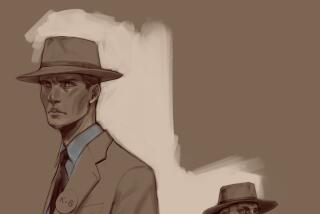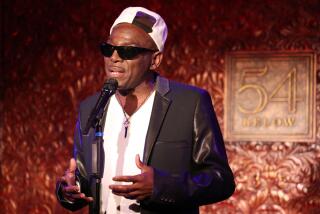Classic Hollywood: Gene Kelly tribute includes famous fans
There are myriad reasons why the Academy of Motion Picture Arts and Sciences is celebrating Gene Kelly’s centennial with two special evenings this Thursday and Friday. After all, he was the complete package, an innovative actor, dancer, choreographer and director.
But let’s not forget another obvious fact — few dancers have looked as sexy on the silver screen. While lean, dapper Fred Astaire, who came into films almost a decade before Kelly in 1933, often danced dressed in a top hat, white tie and tails, the athletic Kelly preferred tight, form-fitting pants and shirts. No wonder it was said that the difference between Astaire and Kelly is that Astaire was the person you went to the dance with and Kelly was the one you went home with.
According to his widow, Patricia Ward Kelly, who is hosting “A Centennial Tribute to Gene Kelly” Thursday evening at the Samuel Goldwyn Theater and “Gene Kelly Choreography and the Camera” Friday at the Linwood Dunn, his attire was “perfectly” designed by her late husband.
“What he would have preferred to wear was a ballet leotard but you can’t come out in the fifth position and play these roles,” she said. “He would have the pants specifically cut so they revealed as much of the line of the body as possible. If you are wearing a suit coat, you don’t see the body, you don’t see the form. If you watch him in the movies, he’s always trying to pare it down to the minimum he can wear.”
Take his uber-romantic dance duet set to the Gershwins’ “Our Love Is Here to Stay” with Leslie Caron in the 1951 Oscar-winning “An American in Paris.” “He takes the jacket off so you have that very streamline polo shirt and slacks that are cut to show his leg,” she said. “You get a much better sense of the dance.”
Ward Kelly said that the whole point of the two-night celebration is not to give her husband, who died in 1996, a “birthday party. This isn’t about Gene Kelly dead and 100. The whole point is to get the message out about how he wished he would be remembered, as someone who was changing the look of dance on film.”
Indeed, Kelly’s work seems just as vital today as it was when he made such classics as 1945’s “Anchors Aweigh,” “An American in Paris” and the three landmark films he co-directed with Stanley Donen, 1949’s “On the Town,” 1952’s”Singin’ in the Rain,” in which he performed his signature routine to the title tune, and 1955’s “It’s Always Fair Weather.”
He brought ballet into movie musicals, most notably the 17-minute balletic and jazz number he choreographed and performed with Leslie Caron in “An American in Paris.” And who can forget the portion of the “Broadway Melody” number in “Singin’ in the Rain” in which he performs with Cyd Charisse?
He kept the camera moving during dance numbers — “there was a method to his madness,” said Ward Kelly. “If you could constantly be coming toward the camera, it created a kinetic sense of movement that gave you a sense of a third dimension.”
The first of the sold-out evenings — there will be standby lines for both — will feature clips from nearly 20 of his films that showcase his creativity dancing with such props as mops (1943’s “Thousands Cheer”) and on roller skates (“It’s Always Fair Weather”), and his astonishing athleticism such as in the Mack the Black number from 1948’s “The Pirate.”
Special guests include contemporary talent who have been inspired by Kelly — pop superstar and actor Justin Timberlake and “Glee” actor/dancer Harry Shum Jr. Another Kelly fanatic, actor and song-and-dance man Hugh Jackman, is sending along a video message. Also scheduled to appear are Nastassja Kinski, who starred in Francis Ford Coppola’s 1982 musical “One from the Heart” — Kelly was an advisor on the film — and Kenny Ortega, who choreographed the 1980 cult musical “Xanadu,” in which Kelly appeared withOlivia Newton-John.
The second evening explores his innovations in musicals with cinematography and animation — he danced with Jerry the Mouse in 1945’s “Anchors Aweigh.” He was among the first to take the dance genre away from the sound stage and out on location in New York City for 1949’s “On the Town.”
“He really was in search of an American language and a way to express American life in film,” said Ward Kelly, who was collaborating on Kelly’s autobiography before his death. “He wanted to break with the European tradition and particularly the European ballroom tradition.
“He wanted to dance to American popular song and he was looking for the type of movement he felt matched the American tone. The best source of that was sports. He went back to the gymnastic training of his youth and baseball, and that’s how he shaped dance you hadn’t seen before.”
For more information on the two Kelly evenings go to https://www.oscars.org
More to Read
The biggest entertainment stories
Get our big stories about Hollywood, film, television, music, arts, culture and more right in your inbox as soon as they publish.
You may occasionally receive promotional content from the Los Angeles Times.







